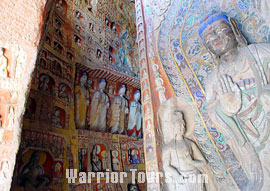- Yungang Grottoes & Wooden Pagoda
- Hanging Monastery & Mt. Hengshan
- Hukou Waterfalls
- Nine-dragon Screen & Huayan Temple
Yungang Grottoes & Wooden Pagoda
![]() Yungang Grottoes
Yungang Grottoes
Located 16 kilometers (10 miles) west of Datong City, Yungang Grottoes is a complex of 45 grottoes carved into the cliffs of Wuzhou Mountain. It is a treasure trove of Buddhist carvings unrivaled in the world with a variety of more than 51,000 statues. Yungang Grottoes, together with Longmen Grottoes in Luoyang, Dunhuang Grottoes and Maijishan Grottoes in Gansu, are considered as the Four Greatest Buddha Grottoes in China.
During the Northern and Southern Dynasties (386 - 589), Buddhism found a receptive audience in China and the emperors of the Northern Wei, took Buddhism as the national religion to enforce their dominion. It resulted in a large amount of construction campaigns of Buddhist temples and grottoes. The construction of Yungang Grottoes began from that time.
Records indicate that construction of the present Cave Nos. 16 to 20 began during 460 to 465 and completed in 524 and these five are the finest examples of Yungang Grottoes. Other grottoes having been carved primarily around 494, and prior to Emperor Xiaowen of the Wei relocating his capital to today's Luoyang in Henan Province.

A range of caves wind a 1000-meter (3,280 feet) path with all sorts of Buddhist statues, continuous wall frescoes and intricate decorative cuttings. All these works present a blending result of both the traditional sculpture skills from China's early Qin (221 B.C.-206 B.C.) and Han (206 B.C. - 220 A.D) dynasties and the essence of Buddhist art at that time. It had a long-term influence on artistic development in the successive Sui (581 - 618) and Tang (618 - 907) dynasties.
The most representative works are a 17-meter-high (56 feet) statue of Sakyamuni in company with many Buddha, Bodhisattva and arhat statues in Cave No. 5 and an intricately carved two-storied quadrate pagoda in Cave No. 6.
| Admission Fee: | CNY 60 |
| Opening Hours: | 8:00 to 17:00 |
| Recommended Time for a Visit: | Two hours |
| Bus Route: | Take No. 4 bus at Datong Railway Station and transfer No. 3 bus at Xin Kaili |

![]() Wooden Pagoda
Wooden Pagoda
Located in Yingxian County, about 70 kilometers (43 miles) from Datong, the six-storied wooden-frame pagoda boasts to be the greatest and the oldest of its kind in China.
The octagonal pagoda is about 70 meters (230 feet) high and appears to consist of six stories. However, the interior of the pagoda has three hidden floors so in total it has nine stories. On each storey of the pagoda, twenty-four pillars in the outer circle support the octagonal eaves and another eight pillars further inside surround the interior body of the pagoda. The pillars are interwoven by a fine latticework of stanchions, beams, and puncheons. The construction of this well-proportioned pagoda used 3,000 cubes of wood at the weight of over 2,600 tons, and with no dowels or nails having being used. This presents the height of development in traditional Chinese wooden architecture of that period.

Two gates built into the base of the pagoda are the main entrance for tourists. A flight of wood cockle stairs inside the pagoda allow tourist to ascend the top. On each floor, there enshrined valued Buddhist statues, among which a 10-meter-high (32.8 feet statue of Sakyamuni on the first floor is very impressive.
In addition, a collection of precious relics found in the pagoda includ the color-printings from the Liao (916 - 1125) period, Buddhist scripts and other items are of high value in the research of the political, economic and cultural development in that period.
| Admission Fee: | CNY 61 (including CNY 1 for insurrance) |
| Opening Hours: | 7:00 to 19:00 |
| Recommended Time for a Visit: | One and a half hours |
| Bus Route: | Take the direct bus at railway station |

